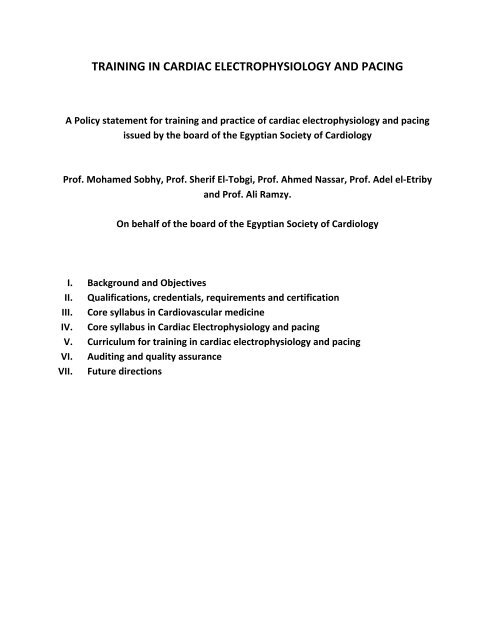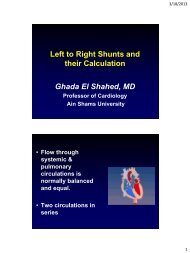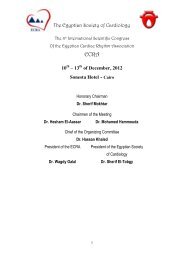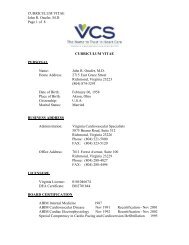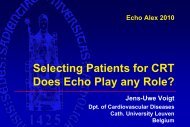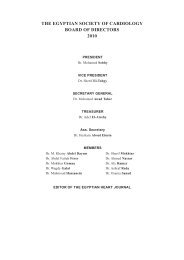training in cardiac electrophysiology and pacing - Cardioegypt.com
training in cardiac electrophysiology and pacing - Cardioegypt.com
training in cardiac electrophysiology and pacing - Cardioegypt.com
Create successful ePaper yourself
Turn your PDF publications into a flip-book with our unique Google optimized e-Paper software.
TRAINING IN CARDIAC ELECTROPHYSIOLOGY AND PACING<br />
A Policy statement for <strong>tra<strong>in</strong><strong>in</strong>g</strong> <strong>and</strong> practice of <strong>cardiac</strong> <strong>electrophysiology</strong> <strong>and</strong> pac<strong>in</strong>g<br />
issued by the board of the Egyptian Society of Cardiology<br />
Prof. Mohamed Sobhy, Prof. Sherif El-‐Tobgi, Prof. Ahmed Nassar, Prof. Adel el-‐Etriby<br />
<strong>and</strong> Prof. Ali Ramzy.<br />
On behalf of the board of the Egyptian Society of Cardiology<br />
I. Background <strong>and</strong> Objectives<br />
II. Qualifications, credentials, requirements <strong>and</strong> certification<br />
III. Core syllabus <strong>in</strong> Cardiovascular medic<strong>in</strong>e<br />
IV. Core syllabus <strong>in</strong> Cardiac Electrophysiology <strong>and</strong> pac<strong>in</strong>g<br />
V. Curriculum for <strong>tra<strong>in</strong><strong>in</strong>g</strong> <strong>in</strong> <strong>cardiac</strong> <strong>electrophysiology</strong> <strong>and</strong> pac<strong>in</strong>g<br />
VI. Audit<strong>in</strong>g <strong>and</strong> quality assurance<br />
VII. Future directions
I. Background <strong>and</strong> Objectives<br />
Cl<strong>in</strong>ical <strong>cardiac</strong> <strong>electrophysiology</strong> is one of the most rapidly grow<strong>in</strong>g subspecialties of<br />
cardiovascular medic<strong>in</strong>e. Advancement <strong>in</strong> technology provides more effective <strong>and</strong> safer<br />
management options for arrhythmia patients. Catheter ablation procedures have emerged as an<br />
effective tool to tackle simple <strong>and</strong> <strong>com</strong>plex arrhythmias like atrial fibrillation <strong>and</strong> scar-‐related<br />
ventricular tachycardia. The tremendous evolution <strong>in</strong> <strong>cardiac</strong> rhythm management devices<br />
<strong>in</strong>clud<strong>in</strong>g pacemakers, implantable loop recorders (ILR), <strong>cardiac</strong> resynchronization therapy (CRT)<br />
<strong>and</strong> implantable cardiovertor defibrillators (ICDs); has offered therapeutic solutions to life-‐<br />
threaten<strong>in</strong>g <strong>cardiac</strong> arrhythmias <strong>and</strong> advanced heart failure. Given the wide spectrum of <strong>cardiac</strong><br />
rhythm problems dealt by the modern <strong>cardiac</strong> electrophysiologist, a well-‐organized <strong>tra<strong>in</strong><strong>in</strong>g</strong><br />
program <strong>in</strong> <strong>cardiac</strong> <strong>electrophysiology</strong> would be highly appreciated.<br />
The objectives of this document would be:<br />
1. To advance the st<strong>and</strong>ard of care delivered to arrhythmia patients <strong>in</strong> Egypt provid<strong>in</strong>g the best<br />
possible service that matches <strong>in</strong>ternational st<strong>and</strong>ards <strong>and</strong> guidel<strong>in</strong>es.<br />
2. To st<strong>and</strong>ardize the required credentials <strong>and</strong> <strong>tra<strong>in</strong><strong>in</strong>g</strong> to practice <strong>cardiac</strong> <strong>electrophysiology</strong> <strong>and</strong><br />
pac<strong>in</strong>g among Egyptian centers <strong>and</strong> departments of Cardiology.<br />
3. To ascerta<strong>in</strong> the essential relationship between appropriate credentials <strong>and</strong> <strong>com</strong>plete <strong>tra<strong>in</strong><strong>in</strong>g</strong><br />
on one h<strong>and</strong> <strong>and</strong> the privilege to practice cardiovascular medical subspecialties on the other.<br />
4. To encourage harmonization of practice patterns <strong>in</strong> different cardiovascular centers <strong>in</strong> Egypt.<br />
Eventually, sett<strong>in</strong>g the stage to acquire uniform database allow<strong>in</strong>g national multi-‐center<br />
registries <strong>and</strong> research activities.<br />
II. Qualifications, credentials, requirements <strong>and</strong> certification<br />
1-‐ Tra<strong>in</strong>ees<br />
A. C<strong>and</strong>idates for <strong>tra<strong>in</strong><strong>in</strong>g</strong> <strong>in</strong> <strong>cardiac</strong> <strong>electrophysiology</strong> <strong>and</strong> pac<strong>in</strong>g should be dedicated specialists <strong>in</strong><br />
cardiovascular medic<strong>in</strong>e. They should have <strong>com</strong>plete education, <strong>com</strong>prehensive knowledge <strong>and</strong><br />
full <strong>tra<strong>in</strong><strong>in</strong>g</strong> <strong>in</strong> cl<strong>in</strong>ical Cardiology <strong>in</strong>clud<strong>in</strong>g basic sciences, pathophysiology, diagnosis <strong>and</strong><br />
management of congenital, valvular, myocardial, coronary <strong>and</strong> vascular heart diseases cover<strong>in</strong>g<br />
all subjects <strong>in</strong>cluded <strong>in</strong> the core syllabus <strong>in</strong> cardiovascular medic<strong>in</strong>e (section III). C<strong>and</strong>idates<br />
should have obta<strong>in</strong>ed one of the follow<strong>in</strong>g degrees <strong>in</strong> cardiovascular medic<strong>in</strong>e:<br />
i. MD <strong>in</strong> cardiovascular medic<strong>in</strong>e <strong>in</strong> one of the departments of Cardiology <strong>in</strong> Egyptian Universities.<br />
ii. Master degree <strong>in</strong> cardiovascular medic<strong>in</strong>e <strong>in</strong> one of the departments of Cardiology <strong>in</strong> Egyptian<br />
Universities.<br />
iii. The Egyptian fellowship <strong>in</strong> cardiovascular medic<strong>in</strong>e from the board of medical education <strong>and</strong><br />
fellowship, M<strong>in</strong>istry of health.
B. C<strong>and</strong>idates should have <strong>com</strong>pleted their <strong>tra<strong>in</strong><strong>in</strong>g</strong> <strong>in</strong> a department of Cardiology supervised by<br />
professors/consultants with a doctorate degree <strong>in</strong> cardiovascular medic<strong>in</strong>e.<br />
C. C<strong>and</strong>idates should have <strong>com</strong>pleted a program of dedicated <strong>tra<strong>in</strong><strong>in</strong>g</strong> <strong>in</strong> cardiovascular<br />
<strong>electrophysiology</strong> <strong>and</strong> pac<strong>in</strong>g as detailed <strong>in</strong> the follow<strong>in</strong>g passages <strong>in</strong>clud<strong>in</strong>g performance of the<br />
required number of procedures (section V).<br />
D. C<strong>and</strong>idates should submit an application endorsed by the re<strong>com</strong>mendation, approval <strong>and</strong><br />
signature of two professors/consultants with an MD degree <strong>in</strong> cardiovascular medic<strong>in</strong>e <strong>and</strong><br />
either 10 years of experience <strong>in</strong> <strong>cardiac</strong> <strong>electrophysiology</strong> <strong>and</strong> pac<strong>in</strong>g or the performance of<br />
1000 diagnostic/<strong>in</strong>terventional EP procedure <strong>and</strong> 500 device implant.<br />
2-‐ The tra<strong>in</strong>ers<br />
A. The program director:<br />
The director of <strong>in</strong>vasive cardiology should be a full professor/consultant <strong>in</strong> Cardiology with<br />
an MD degree <strong>in</strong> cardiovascular medic<strong>in</strong>e. He should be a recognized expert hav<strong>in</strong>g either 10<br />
years of experience <strong>in</strong> <strong>cardiac</strong> <strong>electrophysiology</strong> <strong>and</strong> pac<strong>in</strong>g or the performance of 1000<br />
diagnostic/<strong>in</strong>terventional EP procedure <strong>and</strong> 500 device implant.<br />
B. Other faculty members:<br />
Other tra<strong>in</strong>ers should have an MD degree <strong>in</strong> cardiovascular medic<strong>in</strong>e <strong>and</strong> 5 years of<br />
postgraduate experience <strong>in</strong> <strong>cardiac</strong> <strong>electrophysiology</strong> <strong>and</strong> pac<strong>in</strong>g. The rest of the faculty should<br />
<strong>in</strong>clude experienced members <strong>in</strong> echocardiography, <strong>in</strong>terventional cardiology, congenital <strong>and</strong><br />
valvular heart diseases.<br />
3-‐ The <strong>tra<strong>in</strong><strong>in</strong>g</strong> <strong>in</strong>stitution/department<br />
This should be a fully equipped <strong>and</strong> staffed department specialized <strong>in</strong> cardiovascular<br />
medic<strong>in</strong>e. It should have a coronary care unit, <strong>in</strong>patient ward, non-‐<strong>in</strong>vasive diagnostic<br />
equipments, imag<strong>in</strong>g facilities, facilities for perform<strong>in</strong>g diagnostic <strong>and</strong> <strong>in</strong>terventional<br />
catheterization, congenital heart disease <strong>and</strong> preventive Cardiology programs.<br />
The <strong>in</strong>stitution/department should be run by specialists <strong>in</strong> cardiovascular medic<strong>in</strong>e <strong>and</strong><br />
experts <strong>in</strong> Cardiology subspecialties who are properly certified with Masters <strong>and</strong> MD degrees <strong>in</strong><br />
cardiovascular medic<strong>in</strong>e.<br />
It should carry a regular Cardiology conference for the discussion of cases before <strong>and</strong> after<br />
<strong>in</strong>vasive procedures <strong>and</strong> it should also produce research work <strong>in</strong> cardiovascular medic<strong>in</strong>e.
4-‐ Certification for practice of <strong>cardiac</strong> <strong>electrophysiology</strong> <strong>and</strong> pac<strong>in</strong>g<br />
A certificate offered by the Egyptian Society of Cardiology <strong>and</strong> the Egyptian Medical<br />
Syndicate for <strong>in</strong>dependent practice <strong>in</strong> <strong>cardiac</strong> <strong>electrophysiology</strong> <strong>and</strong> pac<strong>in</strong>g will be offered to<br />
specialists <strong>in</strong> Cardiovascular Medic<strong>in</strong>e upon <strong>com</strong>pletion of the follow<strong>in</strong>g requirements:<br />
i. Obta<strong>in</strong><strong>in</strong>g a Master/MD degree <strong>in</strong> cardiovascular medic<strong>in</strong>e from one of the cardiology<br />
departments <strong>in</strong> Egyptian universities or an Egyptian fellowship <strong>in</strong> cardiovascular<br />
medic<strong>in</strong>e from the board of medical education <strong>and</strong> fellowship, M<strong>in</strong>istry of Health.<br />
ii. Completion of level 2 <strong>and</strong> 3 <strong>tra<strong>in</strong><strong>in</strong>g</strong> <strong>in</strong> Cardiac <strong>electrophysiology</strong> <strong>and</strong> pac<strong>in</strong>g as detailed<br />
below (section V).<br />
III. Core syllabus <strong>in</strong> Cardiovascular medic<strong>in</strong>e<br />
1. Global burden of cardiovascular disease:<br />
• Economic, social <strong>and</strong> demographic transitions<br />
• Rate of changed of epidemiologic transition<br />
• Current worldwide variations <strong>in</strong> the global burden of cardiovascular disease<br />
• Global trends <strong>in</strong> cardiovascular disease<br />
• Regional trends <strong>in</strong> risk factors<br />
2. History <strong>and</strong> physical exam<strong>in</strong>ation of the cardiovascular system:<br />
• Card<strong>in</strong>al symptoms of heart disease<br />
• The history <strong>in</strong> specific forms of heart disease<br />
• Assess<strong>in</strong>g cardiovascular disability<br />
• Physical exam<strong>in</strong>ation of the heart <strong>and</strong> circulation<br />
• The general physical exam<strong>in</strong>ation<br />
• The <strong>cardiac</strong> exam<strong>in</strong>ation<br />
3. Electrocardiography<br />
• Fundamental pr<strong>in</strong>ciples<br />
• Record<strong>in</strong>g electrodes <strong>and</strong> leads<br />
• Cl<strong>in</strong>ical electrocardiographic lead systems<br />
• The electrical axis<br />
• The normal electrocardiogram<br />
• The abnormal electrocardiogram<br />
• Cl<strong>in</strong>ical issues <strong>in</strong> electrocardiographic <strong>in</strong>terpretation<br />
4. Exercise stress test<strong>in</strong>g:<br />
• Exercise physiology
• Exercise protocols<br />
• Electrocardiographic measurements<br />
• Non-‐electrocardiographic observation<br />
• Diagnostic use of exercise test<strong>in</strong>g<br />
• Exercise test<strong>in</strong>g <strong>in</strong> determ<strong>in</strong><strong>in</strong>g prognosis<br />
• Cardiac arrhythmias <strong>and</strong> conduction disturbances<br />
• Specific cl<strong>in</strong>ical applications<br />
• Safety <strong>and</strong> risks of exercise test<strong>in</strong>g<br />
5. Echocardiography:<br />
• Pr<strong>in</strong>ciples of <strong>cardiac</strong> ultrasonography:<br />
o Pr<strong>in</strong>ciples of ultrasound physics <strong>and</strong> <strong>in</strong>strumentation<br />
o The Doppler pr<strong>in</strong>ciple<br />
o The anatomical echocardiographic exam<strong>in</strong>ation<br />
o Exam<strong>in</strong>ation <strong>and</strong> appearance of the normal heart<br />
o Quantification of the ventricular performance<br />
o Pr<strong>in</strong>ciples of the Doppler exam<strong>in</strong>ation<br />
o Additional imag<strong>in</strong>g formats <strong>and</strong> techniques<br />
o Contrast echocardiography<br />
• Cl<strong>in</strong>ical application of echocardiography <strong>in</strong>:<br />
o Acquired valvular heart disease<br />
o Evaluation of prosthetic heart valves<br />
o Congenital heart disease<br />
o Disease of the pericardium<br />
o Cardiomyopathies<br />
o Hypertrophic cardiomyopathy<br />
o Ischemic heart disease<br />
o Diseases of the aorta<br />
o Cardiac masses <strong>and</strong> tumors<br />
6. Cardiovascular imag<strong>in</strong>g:<br />
• The chest radiograph <strong>in</strong> cardiovascular disease<br />
• Nuclear cardiology<br />
• Cardiovascular magnetic resonance<br />
• Computed tomography of the heart<br />
• Relative merits of <strong>cardiac</strong> diagnostic techniques<br />
7. Cardiac catheterization:<br />
• Indications for diagnostic <strong>cardiac</strong> catheterization.<br />
• Technical aspects of <strong>cardiac</strong> catheterization:<br />
o Catheterization laboratory protocol
o Techniques<br />
o Hemodynamic data:<br />
o Pressure measurements<br />
o Cardiac output measurements<br />
o Evaluation of valvular stenosis<br />
o Measurements of <strong>in</strong>tra-‐ventricular pressure gradient<br />
o Shunt determ<strong>in</strong>ation<br />
• Adjunctive diagnostic techniques:<br />
o Coronary pressure <strong>and</strong> blood flow determ<strong>in</strong>ation<br />
o Left ventricular electromechanical mapp<strong>in</strong>g<br />
o Intra-‐<strong>cardiac</strong> echocardiography<br />
• Complications associated with <strong>cardiac</strong> catheterization<br />
• Contrast media <strong>in</strong>duced nephropathy<br />
• Coronary angiography <strong>and</strong> <strong>in</strong>travascular ultrasound imag<strong>in</strong>g<br />
8. Mechanisms of <strong>cardiac</strong> contraction <strong>and</strong> relaxation:<br />
• Microanatomy of contractile cells <strong>and</strong> prote<strong>in</strong>s<br />
• Calcium ion <strong>in</strong>fluxes <strong>in</strong> <strong>cardiac</strong> contraction – relaxation cycle<br />
• Beta adrenergic signal system<br />
• Chol<strong>in</strong>ergic <strong>and</strong> nitric oxide signal<strong>in</strong>g<br />
• Contractile performance of <strong>in</strong>tact heart<br />
• Effects of ischemia <strong>and</strong> reperfusion on contraction <strong>and</strong> relaxation<br />
9. Heart failure:<br />
• Assessment of normal <strong>and</strong> abnormal <strong>cardiac</strong> function<br />
• Pathophysiology of heart failure<br />
• Cl<strong>in</strong>ical aspects of heart failure, pulmonary oedema, high output heart failure<br />
• Drugs <strong>in</strong> the treatment of heart failure<br />
• Management of heart failure<br />
• Assisted circulation <strong>in</strong> the treatment of heart failure<br />
• Heart transplantation<br />
10. Cardiac arrhythmias:<br />
• Genesis of <strong>cardiac</strong> arrhythmias: electrophysiological consideration<br />
• Genetics of <strong>cardiac</strong> arrhythmias<br />
• Diagnosis of <strong>cardiac</strong> arrhythmias<br />
• Therapy for <strong>cardiac</strong> arrhythmias<br />
• Cardiac pacemaker <strong>and</strong> cardioverter defibrillators<br />
• Specific arrhythmias: diagnosis <strong>and</strong> treatment<br />
• Cardiac arrest <strong>and</strong> sudden <strong>cardiac</strong> death
11. Hypotension <strong>and</strong> syncope<br />
12. The vascular biology of atherosclerosis<br />
13. Risk factors of atherothrombotic disease<br />
14. Systemic hypertension therapy<br />
15. Lipoprote<strong>in</strong> disorder <strong>and</strong> cardiovascular disease<br />
16. Diabetes mellitus, the metabolic syndrome, <strong>and</strong> atherosclerotic vascular disease<br />
17. Nutrition <strong>and</strong> cardiovascular disease<br />
18. Primary <strong>and</strong> secondary prevention of coronary heart disease<br />
19. Comprehensive rehabilitation of patients with cardiovascular disease<br />
20. Myocardial ischemia <strong>and</strong> <strong>in</strong>farction:<br />
• Coronary blood flow <strong>and</strong> myocardial ischemia<br />
• Approach to the patient with chest pa<strong>in</strong><br />
• ST elevation myocardial <strong>in</strong>farction: pathology, pathophysiology <strong>and</strong> cl<strong>in</strong>ical features<br />
• ST elevation myocardial <strong>in</strong>farction: management<br />
• Primary percutaneous coronary <strong>in</strong>tervention <strong>in</strong> the management of acute myocardial<br />
<strong>in</strong>farction<br />
• Unstable ang<strong>in</strong>a <strong>and</strong> non ST elevation myocardial <strong>in</strong>farction<br />
• Chronic coronary artery disease<br />
21. Diabetes <strong>and</strong> heart disease.<br />
22. Percutaneous coronary <strong>and</strong> valvular <strong>in</strong>tervention.<br />
• Balloon percutaneous translum<strong>in</strong>al coronary angioplasty.<br />
• Coronary atherectomy.<br />
• Catheter-‐based thrombolysis <strong>and</strong> mechanical thrombectomy.<br />
• Distal embolic protection devices.<br />
• Total occlusion-‐cross<strong>in</strong>g devices.<br />
• Coronary stents<br />
• Cl<strong>in</strong>ical out<strong>com</strong>es <strong>and</strong> <strong>com</strong>plication of percutaneous coronary <strong>in</strong>tervention<br />
• Radiation brachytherapy for <strong>in</strong>stent restenosis<br />
• Vascular closure devices<br />
• Anticoagulation dur<strong>in</strong>g percutaneous coronary <strong>in</strong>tervention<br />
• Pharmacological approaches to restenosis<br />
• Drug-‐elut<strong>in</strong>g stents<br />
• Indications for percutaneous coronary <strong>in</strong>terventions<br />
• Options for medical therapy or coronary revascularization<br />
• Percutaneous valvuloplasty<br />
• Tra<strong>in</strong><strong>in</strong>g st<strong>and</strong>ards <strong>and</strong> proficiency <strong>in</strong> <strong>in</strong>terventional cardiology<br />
23. Diseases of the aorta<br />
24. Peripheral arterial diseases
25. Endovascular treatment of non-‐coronary obstructive vascular disease<br />
26. Congenital heart disease:<br />
• Anatomy <strong>and</strong> embryology<br />
• Pathological consequences of congenital <strong>cardiac</strong> lesions<br />
• Evaluation of patients with congenital heart diseases<br />
• Specific <strong>cardiac</strong> deficits<br />
• Adult congenital heart diseases<br />
27. Valvular heart disease:<br />
• Mitral stenosis<br />
• Mitral regurgitation<br />
• Mitral valve prolapse syndrome<br />
• Aortic stenosis<br />
• Aortic regurgitation<br />
• Tricuspid, pulmonic <strong>and</strong> multivalvular disease<br />
• Prosthetic <strong>cardiac</strong> valves<br />
28. Infective endocarditis<br />
29. The cardiomyopathies<br />
30. Myocarditis<br />
31. Cardiovascular abnormalities <strong>in</strong> HIV <strong>in</strong>fected <strong>in</strong>dividuals<br />
32. Tox<strong>in</strong>s <strong>and</strong> the heart<br />
33. Primary tumors of the heart<br />
34. Pericardial disease<br />
35. Traumatic heart disease<br />
36. Pulmonary embolism<br />
37. Pulmonary hypertension<br />
38. Sleep disorders <strong>and</strong> cardiovascular disease<br />
39. Pr<strong>in</strong>ciples of cardiovascular molecular biology <strong>and</strong> genetics:<br />
• Pr<strong>in</strong>ciples of cell biology <strong>and</strong> cell cycle<br />
• The genetic code: DNA, RNA <strong>and</strong> prote<strong>in</strong><br />
• Pr<strong>in</strong>ciple <strong>and</strong> techniques of molecular biology<br />
• Pr<strong>in</strong>ciples of molecular genetics<br />
• Genetic modification of mice to study human cardiovascular disease<br />
• Gene <strong>and</strong> cell based therapies<br />
40. Genetics <strong>and</strong> cardiovascular disease:<br />
• Genetic factors <strong>in</strong> disease<br />
• Cardiovascular disorders associated with chromosome aberrations<br />
• Congenital heart diseases<br />
• Cardiomyopathies<br />
• Disorders of connective tissue
• Inborn errors of metabolism that affect the cardiovascular system<br />
• Neuromuscular disorders<br />
• Cardiac tumors<br />
• Disorders of the circulation<br />
• Genetic factors predispos<strong>in</strong>g to atherosclerosis<br />
• Abnormal regulation of blood pressure<br />
41. Myocardial regeneration<br />
42. Cardiovascular disease <strong>in</strong> the elderly<br />
43. Cardiovascular disease <strong>in</strong> women<br />
44. Pregnancy <strong>and</strong> cardiovascular disease<br />
45. Cardiovascular disease <strong>in</strong> athletes<br />
46. Medical management of the patient undergo<strong>in</strong>g <strong>cardiac</strong> surgery<br />
47. Anesthesia <strong>and</strong> non-‐<strong>cardiac</strong> surgery <strong>in</strong> patient with heart disease<br />
48. Heart disease <strong>in</strong> various populations<br />
49. Endocr<strong>in</strong>e disorders <strong>and</strong> cardiovascular disease<br />
50. Hemostasis, thrombosis, fibr<strong>in</strong>olysis <strong>and</strong> cardiovascular disease<br />
51. Rheumatic fever<br />
52. Rheumatic disease <strong>and</strong> the cardiovascular system<br />
53. The patient with cardiovascular disease <strong>and</strong> cancer<br />
54. Psychiatric <strong>and</strong> behavioral aspects of cardiovascular disease<br />
55. Neurological disorders <strong>and</strong> cardiovascular disease<br />
56. Interface between renal disease <strong>and</strong> cardiovascular illness<br />
57. Cardiovascular manifestations of autonomic disorders<br />
58. Economics <strong>and</strong> cardiovascular disease<br />
59. Cl<strong>in</strong>ical decision-‐mak<strong>in</strong>g <strong>in</strong> cardiology<br />
60. Measurement <strong>and</strong> improvement of quality of cardiovascular care<br />
61. The pr<strong>in</strong>ciples of cardiovascular drug therapy<br />
62. Care of patients with end-‐stage heart disease<br />
IV. Core syllabus <strong>in</strong> Cardiac Electrophysiology <strong>and</strong> pac<strong>in</strong>g<br />
The core syllabus <strong>in</strong> <strong>cardiac</strong> <strong>electrophysiology</strong> <strong>and</strong> pac<strong>in</strong>g should <strong>com</strong>ply with guidel<strong>in</strong>es<br />
provided by <strong>in</strong>ternational societies (European Heart Rhythm Association 2009 <strong>and</strong> Heart Rhythm<br />
Society 2011) <strong>and</strong> should cover the follow<strong>in</strong>g topics:<br />
1 Normal <strong>and</strong> abnormal anatomy of the heart <strong>and</strong> the conduction system.<br />
2 Normal <strong>and</strong> abnormal general physiology <strong>and</strong> heart EP, <strong>in</strong>clud<strong>in</strong>g ion channels, cellular EP,<br />
autonomous system <strong>in</strong>fluences, <strong>and</strong> the basic mechanisms of rhythm disorders, syncope, <strong>and</strong><br />
sudden death.
3 Arrhythmic disorders (epidemiology, genetics, pathophysiology, cl<strong>in</strong>ical features <strong>and</strong><br />
diagnosis, prognosis <strong>and</strong> risk evaluation, treatment, prevention, ESC guidel<strong>in</strong>es)<br />
3.1 S<strong>in</strong>us node <strong>and</strong> atrial impulse formation <strong>and</strong> conduction disorders<br />
3.2 Atrioventricular (AV) nodal <strong>and</strong> His–Purk<strong>in</strong>je conduction disorders<br />
3.3 Atrial <strong>and</strong> thoracic ve<strong>in</strong> ectopy <strong>and</strong> tachycardias<br />
3.4 Atrial flutter<br />
3.5 Atrial fibrillation<br />
3.6 Junctional <strong>and</strong> AV node ectopy <strong>and</strong> tachycardias<br />
3.7 Accessory pathway-‐mediated tachycardias<br />
3.8 Ventricular ectopy <strong>and</strong> tachycardias<br />
3.9 Ventricular fibrillation<br />
3.10 Autonomic disorders (carotid s<strong>in</strong>us hypersensitivity, neurocardiogenic syncope,<br />
<strong>and</strong> other)<br />
4 Arrhythmogenic diseases <strong>and</strong> syndromes (epidemiology, genetics, pathophysiology, cl<strong>in</strong>ical<br />
features <strong>and</strong> diagnosis, prognosis <strong>and</strong> risk evaluation, treatment, prevention, ESC guidel<strong>in</strong>es)<br />
4.1 Ischaemic cardiomyopathy<br />
4.2 Non-‐ischaemic cardiomyopathies<br />
4.2.1 Idiopathic dilated cardiomyopathies<br />
4.2.2 Hypertrophic cardiomyopathies<br />
4.2.3 Right ventricular arrhythmogenic cardiomyopathies<br />
4.2.4 Neuromuscular cardiomyopathies<br />
4.2.5 Valvular-‐related cardiomyopathies<br />
4.2.6 Congenital diseases<br />
4.2.7 Other (Chagas disease, etc.)<br />
4.3 Channelopathies <strong>and</strong> other <strong>in</strong>herited syndromes<br />
4.3.1 Long <strong>and</strong> short QT syndromes<br />
4.3.2 Brugada syndrome<br />
4.3.3 Catecholam<strong>in</strong>ergic polymorphic ventricular tachycardia<br />
4.3.4 Congenital conduction disorders<br />
4.3.5 Other<br />
4.4 Other situations lead<strong>in</strong>g to rhythm disorders<br />
5 Diagnostic procedures <strong>and</strong> techniques <strong>in</strong> heart rhythmology <strong>and</strong> cl<strong>in</strong>ical EP (rationale,<br />
materials <strong>and</strong> equipment, techniques <strong>and</strong> procedures, <strong>com</strong>plications, result <strong>in</strong>terpretation,<br />
<strong>in</strong>dications <strong>and</strong> contra<strong>in</strong>dications, ESC guidel<strong>in</strong>es)<br />
5.1 Cl<strong>in</strong>ical evaluation (history <strong>and</strong> physical exam<strong>in</strong>ation)<br />
5.2 Electrocardiography (ECG)<br />
5.2.1 Conventional 12-‐lead ECG<br />
5.2.2 ECG monitor<strong>in</strong>g (Holter, event monitor<strong>in</strong>g, implantable event <strong>and</strong> loop<br />
monitor<strong>in</strong>g)<br />
5.2.3 Heart rate variability <strong>and</strong> baroreflex sensitivity<br />
5.2.4 Signal-‐averaged ECG<br />
5.2.5 T-‐wave <strong>and</strong> micro-‐T-‐wave alternants
5.2.6 Body surface mapp<strong>in</strong>g<br />
5.3 ECG–pharmacological tests<br />
5.3.1 Type I drugs for His–Purk<strong>in</strong>je system challenge<br />
5.3.2 Type I drugs for Brugada ECG unmask<strong>in</strong>g<br />
5.3.3 Adrenal<strong>in</strong>e for congenital long QT syndrome unmask<strong>in</strong>g<br />
5.3.4 Adrenal<strong>in</strong>e/atrop<strong>in</strong>e for s<strong>in</strong>us node dysfunction<br />
5.3.5 Adenos<strong>in</strong>e/ATP for s<strong>in</strong>us node <strong>and</strong> AV node dysfunction<br />
5.3.6 Other<br />
5.4 Exercise tests<br />
5.5 General knowledge <strong>in</strong> imag<strong>in</strong>g techniques (fluoroscopy, echocardiography,<br />
magnetic resonance imag<strong>in</strong>g, <strong>com</strong>puted tomography, nuclear imag<strong>in</strong>g, angiograms, <strong>and</strong><br />
other)<br />
5.6 Autonomic nervous system evaluation<br />
5.6.1 Carotid s<strong>in</strong>us massage<br />
5.6.2 Sup<strong>in</strong>e to orthostatism for orthostatic hypotension evaluation<br />
5.6.3 Tilt test<strong>in</strong>g<br />
5.6.4 Other<br />
5.7 Transoesophageal electrical evaluation<br />
5.8 Invasive EP studies<br />
5.9 Other<br />
6 Therapies <strong>in</strong> heart rhythmology <strong>and</strong> cl<strong>in</strong>ical EP (rationale, material <strong>and</strong> equipment,<br />
techniques <strong>and</strong> procedures, side effects <strong>and</strong> <strong>com</strong>plications, results, <strong>in</strong>dications <strong>and</strong><br />
contra<strong>in</strong>dications, ESC guidel<strong>in</strong>es)<br />
6.1 Physical <strong>and</strong> autonomous system manoeuvres<br />
6.2 Resuscitation <strong>and</strong> life support<br />
6.3 Drugs with antiarrhythmic effects<br />
6.4 Drugs for associated rhythm problems (anticoagulants, vasodilators, <strong>and</strong> other)<br />
6.5 Transient electrical stimulation<br />
6.5.1 Transcutaneous<br />
6.5.2 Transoesophageal<br />
6.5.3 Intra<strong>cardiac</strong> percutaneous<br />
6.6 Cardioversion <strong>and</strong> defibrillation<br />
6.7 Invasive EP-‐guided therapies<br />
6.8 Percutaneous catheter ablation<br />
6.9 Implantable HR devices (PMs, ICDs, CRTs, <strong>and</strong> other)<br />
6.10 General knowledge of <strong>cardiac</strong> <strong>and</strong> antiarrhythmic surgery<br />
6.11 Other<br />
7 Professional, legal, ethical, <strong>and</strong> socio-‐economical aspects
V. Curriculum for <strong>tra<strong>in</strong><strong>in</strong>g</strong> <strong>in</strong> <strong>cardiac</strong> <strong>electrophysiology</strong> <strong>and</strong> pac<strong>in</strong>g<br />
The curriculum for <strong>tra<strong>in</strong><strong>in</strong>g</strong> <strong>in</strong> <strong>cardiac</strong> <strong>electrophysiology</strong> <strong>and</strong> pac<strong>in</strong>g <strong>and</strong> the post-‐<strong>tra<strong>in</strong><strong>in</strong>g</strong><br />
exam<strong>in</strong>ation are the same applied <strong>and</strong> conducted for several years <strong>in</strong> the department of<br />
cardiovascular medic<strong>in</strong>e, A<strong>in</strong>-‐Shams University. The post-‐<strong>tra<strong>in</strong><strong>in</strong>g</strong> exam<strong>in</strong>ation <strong>in</strong>cludes both a<br />
theoretical part <strong>and</strong> a practical part. (For further <strong>in</strong>formation, refer to Prof. Mervat Aboul-‐Maaty<br />
Nabih) 1 . The <strong>tra<strong>in</strong><strong>in</strong>g</strong> program <strong>in</strong>volves the follow<strong>in</strong>g levels:<br />
Level 1 (3 months – Cardiac arrhythmia <strong>and</strong> EP core)<br />
Basic knowledge:<br />
• Basic electrocardiographic knowledge <strong>and</strong> <strong>in</strong>terpretation<br />
• Diagnosis <strong>and</strong> management of bradyarrhythmias <strong>and</strong> tachyarrhythmias<br />
• Electrocardiographic manifestations of arrhythmias<br />
• Indications for <strong>and</strong> limitations of electrophysiologic studies<br />
• Ability to <strong>in</strong>terpret basic <strong>in</strong>tra<strong>cardiac</strong> record<strong>in</strong>gs such as AH, HV <strong>in</strong>tervals<br />
• Differentiation of a supraventricular <strong>and</strong> ventricular tachycardia<br />
• Use of antitachycardia pac<strong>in</strong>g to term<strong>in</strong>ate tachyarrhythmias<br />
• Proper use of antiarrhythmic agents, <strong>in</strong>clud<strong>in</strong>g drug <strong>in</strong>teractions <strong>and</strong> proarrhythmic<br />
potential<br />
• Appropriate <strong>in</strong>dications for catheter ablation procedures<br />
• Fundamentals of <strong>cardiac</strong> pac<strong>in</strong>g<br />
• Recogniz<strong>in</strong>g normal <strong>and</strong> abnormal pacemaker function<br />
• Indications for temporary <strong>and</strong> permanent pac<strong>in</strong>g <strong>and</strong> the implantation of ICDs<br />
• Pac<strong>in</strong>g modes<br />
• Underst<strong>and</strong><strong>in</strong>g basic techniques for <strong>in</strong>terrogation, programm<strong>in</strong>g, <strong>and</strong> surveillance of<br />
pacemakers <strong>and</strong> ICDs.<br />
• Indications <strong>and</strong> limitations of biventricular pac<strong>in</strong>g <strong>in</strong> patients with congestive heart<br />
failure<br />
• Indications <strong>and</strong> technique of elective <strong>and</strong> emergency cardioversions<br />
Procedures:<br />
1 drnabih@yahoo.<strong>com</strong><br />
• Exposure to <strong>and</strong> <strong>in</strong>terpretation of non<strong>in</strong>vasive techniques related to the diagnosis <strong>and</strong><br />
management of patients with <strong>cardiac</strong> arrhythmias <strong>in</strong>clud<strong>in</strong>g ambulatory<br />
electrocardiographic monitor<strong>in</strong>g, event recorders, ILRs <strong>and</strong> exercise test<strong>in</strong>g for<br />
arrhythmia assessment <strong>and</strong> tilt-‐table test<strong>in</strong>g
• Insertion, management, <strong>and</strong> follow-‐up of temporary pacemakers <strong>in</strong>clud<strong>in</strong>g<br />
measurement of pac<strong>in</strong>g <strong>and</strong> sens<strong>in</strong>g thresholds <strong>and</strong> record<strong>in</strong>g of <strong>in</strong>tra<strong>cardiac</strong><br />
electrograms (m<strong>in</strong>imum of 10)<br />
• Deliver<strong>in</strong>g elective <strong>and</strong> emergency cardioversions (m<strong>in</strong>imum of 10)<br />
Level 2 (6 months – Advanced non-‐<strong>in</strong>vasive EP management)<br />
Essential knowledge:<br />
• Thorough knowledge <strong>and</strong> demonstration of proficiency <strong>in</strong> Level 1 items.<br />
• Competency <strong>in</strong> <strong>in</strong>terpretation of <strong>in</strong>vasive electrophysiologic study data, <strong>and</strong> <strong>com</strong>plex<br />
arrhythmia electrocardiograms<br />
Procedures:<br />
• Demonstration of proficiency <strong>in</strong> the performance <strong>and</strong> <strong>in</strong>terpretation of non<strong>in</strong>vasive tests<br />
related to the evaluation of arrhythmia patients<br />
• Interrogation, <strong>in</strong>terpretation <strong>and</strong> programm<strong>in</strong>g of all types of bradycardia pac<strong>in</strong>g,<br />
biventricular pac<strong>in</strong>g, <strong>and</strong> ICD systems (m<strong>in</strong>imum of 100 patients)<br />
• Competency <strong>in</strong> temporary pac<strong>in</strong>g <strong>and</strong> cardioversion<br />
Level 3 (18 months – Cl<strong>in</strong>ical <strong>in</strong>vasive <strong>cardiac</strong> EP)<br />
Essential knowledge:<br />
• Master<strong>in</strong>g the scientific background beh<strong>in</strong>d <strong>in</strong>vasive EP procedures <strong>in</strong>clud<strong>in</strong>g catheter<br />
placement, programmed electrical stimulation, endocardial mapp<strong>in</strong>g, catheter ablation,<br />
<strong>and</strong> <strong>in</strong>terpretation of data dur<strong>in</strong>g the study. A thorough knowledge of possible<br />
<strong>com</strong>plications <strong>and</strong> their management is m<strong>and</strong>atory<br />
• Extensive knowledge of ICD/CRT <strong>in</strong>dications, contradictions, <strong>and</strong> management of<br />
<strong>com</strong>plications; an underst<strong>and</strong><strong>in</strong>g of drug– <strong>and</strong> pacemaker–ICD <strong>in</strong>teractions; <strong>and</strong> a<br />
thorough knowledge of ICD programm<strong>in</strong>g <strong>and</strong> management of ICD malfunction <strong>and</strong><br />
postoperative <strong>com</strong>plications<br />
Procedures:<br />
• Performance of at least 150 electrophysiologic studies <strong>and</strong>/or ablation procedures<br />
• Implantation of a m<strong>in</strong>imum of 75 antiarrhythmic devices ( 30 as a primary operator)<br />
<strong>in</strong>clud<strong>in</strong>g left ventricular lead implantation procedures
• Performance of ICD defibrillation threshold test<strong>in</strong>g <strong>and</strong> manag<strong>in</strong>g high defibrillation<br />
thresholds<br />
• Performance of at least 10 trans-‐septal catheterization procedures<br />
VI. Audit<strong>in</strong>g <strong>and</strong> quality assurance<br />
The credentials <strong>com</strong>mittee with the Egyptian Society of Cardiology will assign officers from<br />
each <strong>in</strong>stitution for implementation <strong>and</strong> quality assurance of the <strong>tra<strong>in</strong><strong>in</strong>g</strong> program.<br />
Members of the credentials <strong>com</strong>mittee <strong>and</strong> the members of the Egyptian medical syndicate<br />
will assume audit<strong>in</strong>g responsibilities <strong>and</strong> will report their f<strong>in</strong>d<strong>in</strong>gs to the <strong>com</strong>mittee <strong>and</strong> to the<br />
participat<strong>in</strong>g centers.<br />
VII. Future directions<br />
The practice patterns, re<strong>com</strong>mendations <strong>and</strong> guidel<strong>in</strong>es are always chang<strong>in</strong>g with the<br />
appearance of <strong>in</strong>novations, new trials <strong>and</strong> evidence. This will reflect on future modifications of<br />
this document.


